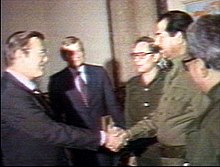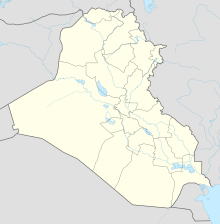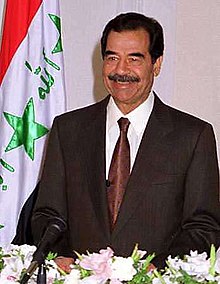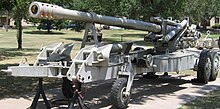Iraq's chemical weapons program
The Iraqi chemical weapons program existed from 1979 to 1991. The Geneva Protocol on the prohibition of the use of asphyxiating, poisonous or other gases, and of Bacteriological Methods of Warfare of 17 June 1925 joined the Iraq during April 7 1931st The entry into force for Iraq took place on September 8, 1931. Despite this ban, Iraq developed chemical weapons from 1979 to 1991 in Project 922 and used them in military operations in the First Gulf War (1980–1988) and the Anfal Operation (1988) a. More than 10,000 people were killed by chemical weapons and more than 50,000 were seriously injured.
Beginnings
In 1968 the Iraqi Chemical Corps was founded on what is now the Al-Rashid military base, and its army officers were trained in chemical warfare by the USA and Russia. In 1974 the Al-Hazen-Ibn-Al-Haitham Institute was founded, which made the first attempts to manufacture chemical weapons. Captain Ghassan Ibrahim became head, Faiz Shahin his deputy. The institute was under the control of the Iraqi secret service . In 1975 the unit moved to near Samarra (al-Muthanna); the chemical weapons program was now called Project 1/75 , and Lieutenant General Nizar Attar was in charge . The Moscow-trained doctors Imad Hussein el-Ani, Salah-al-Din Abda Ilah and Hammad Shakir joined the team. In 1979, with the rise of Saddam Hussein , Project 1/75 gained the capacity to begin a large-scale chemical weapons program. In 1980 Project 1/75 was renamed Project 922 , now able to manufacture chemical weapons on an industrial scale.
Since 1975 Iraq has been supplied with technical equipment and know-how from 50 international companies - including 24 from the USA - covering the entire spectrum of nuclear, biological and chemical warfare agents and missile technology.
Structures
Project 922 was directly under the Ministry of Industry and Military Industrialization . Its head from 1982 was General Hussein Kamel , who was responsible for the Iraqi missile program as well as chemical and biological weapons development . Deputy and subordinate were Lieutenant General Amer al Sa'adi and Lieutenant General Amer M. Rasheed. Through a restructuring in 1987 Major General Faiz Shahin (former deputy of the Al-Hazen-Ibn-Al-Haitham Institute) succeeded Hussein Kamel and at the same time replaced the head of Project 922 , General Nizar Attar. However, Hussein Kamel remained superordinate as the head of the Office of National Security , the "supervisor".
The chemical weapons program, covertly under the State Establishment for Pesticide Production , was renamed the Muthanna State Establishment , based near Samarra ; From 1975 to 1987 General Nizar Attar was in charge. 60 Dr. rer. nat , 200 engineers and 600 technicians comprised the permanent staff, a total of about 2,000 employees for the chemical weapons program in the years 1981–1991. Over 80 percent of the doctors and 40% of the engineers were trained in the west. Over the years, Iraq developed the automation of the manufacture and filling of chemical weapons. In 1982 every single grenade was filled by hand (35 per hour), in 1985 there was a semi-automatic filling station, in 1986 a fully automatic filling system. At the peak of its capacity, the Iraqi chemical weapons program could produce 8-11 tons of poison gas per day. Five main complexes, al-Muthanna, Fallujah 1, 2, 3 and Muhammadyiat made up the Muthanna State Establishment complex .
First Gulf War
Subcontracting and manufacturing
Iraq was supplied with basic chemicals, equipment and bomb containers from various countries. Iraq claimed in 1991 that it had received 17,602 tons of commodity chemicals.
List of countries that supplied basic substances, equipment and bomb containers / missile warheads for chemical weapons:
| country | Basic substances in tons |
Equipment in percent |
Bomb container in numbers |
|---|---|---|---|
| Egypt | 2,400 | 28,500 | |
| Brazil | 100 | ||
| People's Republic of China | 45,000 | ||
| Germany | 1,027 | 52.6% | |
| France | 21.6% | ||
| India | 2,343 | ||
| Italy | 75,000 | ||
| Luxembourg | 650 | ||
| Netherlands | 4,261 | ||
| Austria | 16.0% | ||
| Singapore | 4,515 | ||
| Spain | 4.4% | 57,500 |
"West German companies with East German design" built a chemical factory in al-Muthanna between 1982 and 1983 under the guise of pesticide production. From 1983, specialists from Egypt modified the BM-21 rocket launcher and the 122 mm rockets with plastic inserts on the warheads for the use of chemical warfare agents (sarin).
As UNMOVIC found in its 2006 report, Iraq had already produced ten tons of mustard gas (lost) in 1981 . Over the years, Tabun , Sarin and VX were added. Iraq had produced 3,850 tons of chemical warfare agents by 1991, of which 3,300 tons were ammunitioned.
commitment
In its statement of November 18, 1980, the Iranian Foreign Ministry already stated that the Iraqi army had used chemical weapons, which had apparently been dropped in canisters over Iranian positions. On August 9, 1983, an Iraqi poison gas attack took place during Iran's Operation Dawn 4 on the Rawanduz – Piranschahr highway . The next known use of poison gas took place on January 26, 1984, then on February 29, 1984. The victims were shown to the international press in Tehran. On February 16, 1984, the Iranian Foreign Minister published 49 cases of chemical weapons use on the Iraqi side on a total of forty sectors of the front, killing 109 soldiers. The Iranians injured by poison gas on March 2, 1984 were flown to Austria, Sweden and Switzerland for treatment; the Iranians injured on March 15, 1984 were flown to Germany for treatment.
List of chemical attacks by Iraq on Iranian positions from 1983 to 1988:
| year | Attacks | dead | Injured |
|---|---|---|---|
| 1983 | 20th | 19th | 2,515 |
| 1984 | 47 | 34 | 2,343 |
| 1985 | 90 | 51 | 10,546 |
| 1986 | 47 | 11 | 6,537 |
| 1987 | 33 | 5390 | 16,670 |
| 1988 | 47 | 260 | 4,284 |
| total | 284 | 5,765 | 42,931 |
List of chemical explosives shot down until 1988:
| specification | size | Poison gas | Amount of poison gas per explosive device |
Working time | number |
|---|---|---|---|---|---|
| Aerial bomb | BR-250 kg |
Mustard gas sarin tabun |
60 ltr. | 1983-88 | 6,500 |
| Aerial bomb | BR-500 kg |
Mustard gas sarin tabun |
120 ltr. | 1983-88 | 12,000 3 with VX (test only) |
| Aerial bomb | DB-2 | Sarin | 260 ltr. | 1988 | 155 |
| Artillery ammunition | 130 mm | Mustard gas | 1.9 ltr. | 1982-83 | 4,000 |
| Artillery ammunition | 155 mm | Mustard gas | 3.5 ltr. | 1984-88 | 54,550 |
| Rocket launcher | 122 mm | Sarin | 5–8 ltr. | 1986-88 | 27,000 |
| total | 104.205 |
Attitude and devaluation
Iraqi propaganda spoke of the "Khomeini hordes" or "Persian Huns" that Iraq would have to stop in order to secure the eastern border of the Arab world. One of the responsible front line commanders, Major General Mahir Abdul Rashid, compared the poison gas attacks against Iranian positions with the fight against insects:
"Great sir, we are happy to inform you of the extermination of thousands of harmful magician * insects [* meaning Persians] carried out in a successful offensive last night. [...] We turned what was left of the harmful insects into bird and fish feed. "
"If you give me a pesticide, I'll throw it on the swarms of insects."
When asked by an engineer what would be done here [al-Muthanna]:
"We manufacture agents against vermin - against bed bugs, fleas, locusts, Persians, Israelis"
Anfal surgery

Saddam Hussein also used poison gas against his own Kurdish civilian population. The poison gas attack on Halabja became known to the world public . The comparable poison gas attack on Sardasht , an Iranian city, which took place 9 months before the attack on Halabja, only found media coverage as a result of the exposure of the poison gas attack on Halabja. Another 40 attacks with poison gas on Kurdish towns and cities such as in the area around Sulaimaniyya (February 29, 1988) and Marivan (March 22, 1988, 31 dead, 450 injured) are less known.
International reactions
Because of Iran's poor relations with the international community, protests against Iraq regarding its use of poisonous gases were only moderate. On March 26, 1984, the United Nations Security Council had solid evidence of the use of poison gas on the Iraqi side. The State Department was anxious to get at the question of the use of poison gas against the Iraqi government the right "timing" to bilateral relations not to compromise. The UN resolution 582 (1986) of February 24, 1986 for the first time states the use of poison gas and warns both parties to the conflict (Iran and Iraq) to adhere to the Geneva Protocol. UN resolution 612 (1988) of May 9, 1988 expects both parties to forego the use of chemical weapons in the future.
This set the global political response. In the First Gulf War, both warring parties were accused of using poison gas.
Second Gulf War and Iraq War
With the beginning of the Second Gulf War , Iraq stopped the production of chemical weapons. After the Second Gulf War, Iraq declared 56,281 explosive devices that were / were not yet filled with poison gas as residual stocks. By UN Resolution 687 (1991), Iraq was bound to have all investigations carried out with regard to the Geneva Protocol and, if available, to destroy chemical weapons. Until 1994 these were destroyed under the supervision of the UN.
The United Nations Special Commission worked in Iraq until the end of 1998 - Operation Desert Fox and internal disagreements ended this. As of November 27, 2002 , the United Nations Monitoring, Verification and Inspection Commission ( UNMOVIC ) worked in Iraq on the basis of Resolution 1441 of the UN Security Council . One of the reasons for the Iraq war was that Iraq (still) had chemical weapons of mass destruction that would pose an acute threat. This could not be corroborated. However, 53 chemical weapons-filled rockets and grenades stolen from ammunition bunkers or other locations were seized.
Convictions and Consequences
Hussein Kamel was executed on February 23, 1996 after he returned to Iraq. Ali Hasan al-Majid was sentenced to death on January 17, 2010 as the person primarily responsible for the poison gas attack on Halabja , and was executed on January 25, 2010. Frans van Anraat was sentenced to 17 years in prison for delivering thousands of tons of chemicals to Iraq to produce poisonous gas. According to the Federal Government, no export or other permit was required under foreign trade law or under the provisions of the KWKG . However, with effect from May 15, 1984, the Federal Government has the export of the following chemical products
- a) methylphosphonic acid dimethyl ester ,
- b) methylphosphonic acid difluoride ,
- c) methylphosphonic acid dichloride ,
- d) phosphorus oxychloride ,
- e) thiodiglycol
subject to a reservation of approval.
In connection with Iraq's chemical weapons program, the Chemical Weapons Convention of September 3, 1992 and the Wassenaar Agreement of May 12, 1996 were created as an extension of the Geneva Protocol .
Remarks
- ↑ The later "buyer" for Iraq was Dr. Imad Hussein el-Ani. → See: "Bugs, Fleas, Persians, Israelis" . In: Der Spiegel . No. 16 , 1992 ( online ).
- ↑ USA and Moscow.
- ↑ All facilities were bombed and badly damaged during the Second Gulf War.
- ↑ See: dipbt.bundestag.de (PDF; 524 kB) printed matter 12/487 .
- ↑ See: Frans van Anraat .
-
^ The Karl Kolb company, mentioned by name in the CIA report, had set up five research laboratories. The production facilities have been declared as "multi-purpose pilot facilities". In addition, Pilot Plant from Dreieich in Hesse and Water Engineering Trading from Hamburg are said to have acted as suppliers. → See: "Bugs, Fleas, Persians, Israelis" . In: Der Spiegel . No. 16 , 1992 ( online ). , Zeit.de .
For more information on WET → See: WET Water Engineering Trading GmbH
Company founder Karl Kolb received the Federal Cross of Merit in 1983 . → See: Bruno Schrep: “A toast to comfort” . In: Der Spiegel . No. 8 , 1991 ( online ). - ↑ Mahir Abdul Rashid was the commander of the 3rd Iraqi Army Corps and was responsible for the Basra region. He was considered an Iraqi war hero, his daughter was married to Qusai Hussein . See: Maher Abd al-Rashid .
- ↑ Rashid is referring to the Iranian Operation Kheibar (February 25 to March 9, 1984, attack on the marshland), in which 1,200 Iranian soldiers were killed and 5,000 injured.
- ↑ In that order.
- ↑ UN resolution 612 came 6 weeks after the poison gas attack on Halabja.
- ↑ However, the use of chemical weapons is said to have played a role in the suppression of the uprising in Iraq in 1991 . Compare: Page no longer available , search in web archives: globalsecurity.org ( page no longer available , search in web archives ) Info: The link was automatically marked as defective. Please check the link according to the instructions and then remove this notice. Iraq Survey Group Final Report.
- ^ This is also the case with Hussein Kamel in an interview with Rolf Ekéus on August 25, 1995 . → See: downingstreetmemo.com (PDF; 466 kB)
- ↑ Mustard gas was burned at 1,100 degrees, sarin was charged with explosive charges and detonated using diesel oil, nerve toxins were hydrolyzed with sodium hydroxide . → See: labor-spiez.ch: The Iraqi chemical weapons ( Memento of November 10, 2007 in the Internet Archive ) (PDF; 723 kB).
- ↑ Iraq signed on January 13, 2009.
Web links
- Final report of the UN ( Memento of October 29, 2013 in the Internet Archive ) (PDF; 13.6 MB)
- Picture by Al-Muthanna ( Memento from April 27, 2010 in the Internet Archive ) (Source: CIA)
- Photo of the remains of chemical weapons ( Memento from April 18, 2009 in the Internet Archive ) (Source: CIA)
Individual evidence
- ↑ admin.ch (PDF; 493 kB) Geneva Protocol , accessed on January 10, 2013.
- ^ A b Al Muthanna Chemical Weapons Complex. In: cia.gov. CIA , April 23, 2007, accessed January 14, 2013 .
- ↑ Freedom of Information Center: US Corps In Iraq ( January 19, 2003 memento in the Internet Archive ), accessed January 10, 2013
- ↑ Exclusive: The Secret List of Arms Suppliers - Saddam's Business Partners - taz, 2002
- ↑ Daily newspaper list of companies (accessed on August 10, 2015)
- ↑ German companies supplied weapons to Iraq - FAZ, 2002.
- ↑ Final report of the UN ( Memento of October 29, 2013 in the Internet Archive ) (PDF; 13.6 MB) The Chemical Weapons Program , accessed on January 11, 2013.
- ↑ nytimes.com The World; The Means to Make the Poisons Came From the West . Retrieved January 10, 2013.
- ↑ iraqwatch.org ( Memento of May 4, 2006 in the Internet Archive ) Graphic, accessed on January 10, 2013.
- ^ Iraq's Chemical Warfare Program. In: cia.gov. CIA , April 23, 2007, accessed January 10, 2013 .
- ↑ a b UNMOVIC: Twenty-fifth quarterly report on the activities of the United Nations Monitoring, Verification and Inspection Commission in accordance with paragraph 12 of Security Council resolution 1284 (1999) (PDF; 76 kB).
- ↑ a b c globalsecurity.org Iraq Survey Group Final Report , accessed January 10, 2013.
- ↑ Message d. Islamic Republic of Iran, press and Culture Department (Ed.): Iran and the Islamic Republic: On the Iraqi-Iranian War . Bonn 1981, p. 41.
- ^ Henner Fürtig : The Iraqi-Iranian War . Akademie Verlag GmbH, 1992, ISBN 3-05-001905-0 , p. 81.
- ↑ Stockholm International Peace Research Institute: CHEMICAL WARFARE IN THE IRAQ-IRAN WAR ( Memento of May 13, 2009 in the Internet Archive ) (PDF; 678 kB), accessed on January 16, 2013; (PDF; 678 kB)
- ↑ Fariborz Riyahi: Ayatollah Khomeini . Ullstein, 1986, ISBN 3-548-27540-0 , p. 128.
- ↑ According to Iranian sources, see: Farhang Rajaee: The Iran-Iraq War. University Press 1993, ISBN 978-0-8130-1176-9 , p. 34.
- ↑ Western figures assume 50,000 wounded and 5,000 killed soldiers as a result of Iraqi chemical weapons deployments. See: Oliver Thränert: Iran and the spread of NBC weapons , Science and Politics Foundation, Berlin 2003, ISSN 1611-6372
- ^ Henner Fürtig: Brief history of Iraq. From the foundation in 1921 to the present. Beck, 2003, ISBN 3-406-49464-1 , p. 112.
- Jump into battle with the Paradise Key . In: Der Spiegel . No. 31 , 1982 ( online ).
- ^ Dilip Hiro: The Longest War . The Iran-Iraq Military Conflict. New York: Routledge Chapman & Hall, Inc., 1991, ISBN 0-415-90407-2 , pp. 108, 109.
- ↑ "Bugs, Fleas, Persians, Israelis" . In: Der Spiegel . No. 16 , 1992 ( online ).
- ↑ dipbt.bundestag.de (PDF; 96 kB) A small request to the Federal Government, printed matter 17/837, accessed on January 9, 2013.
- ↑ cbw-events.org.uk (PDF; 91 kB) Iraq and Chemical & Biological Warfare , accessed on January 10, 2013.
- ↑ UN-SC S 16433, March 26, 1984 (PDF; 2.2 MB).
- ↑ gwu.edu (PDF; 70 kB) US State Department to the Iraqi State Secretary , March 1984.
- ↑ RESOLUTION 582 (1986) (PDF; 157 kB)
- ↑ RESOLUTION 612 (1988)
- ↑ Nikki R. Keddie: Modern Iran: Roots and Results of Revolution , Yale University 2006, ISBN 978-0-300-12105-6 , p. 369.
- ↑ Annex B STATUS OF THE VERIFICATION OF IRAQ'S CHEMICAL WEAPONS PROGRAM ( Memento from February 25, 2013 in the Internet Archive ) accessed on January 10, 2013.
- ↑ RESOLUTION 687 (1991) ( Memento from March 5, 2016 in the Internet Archive ).
- ↑ ag-friedensforschung.de We were wrong in almost everything , accessed on January 14, 2013.
- ↑ dipbt.bundestag.de (PDF; 472 kB) Printed matter 10/1710 of July 2nd , 1984 , accessed on January 13, 2013.







